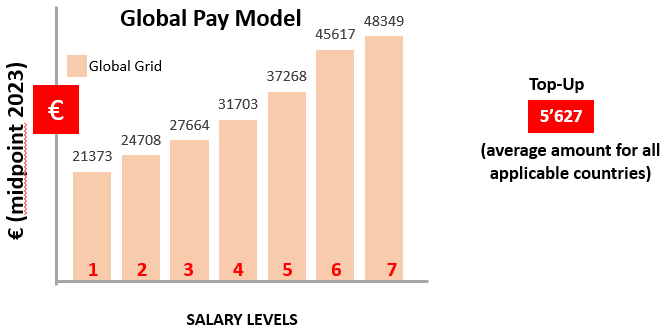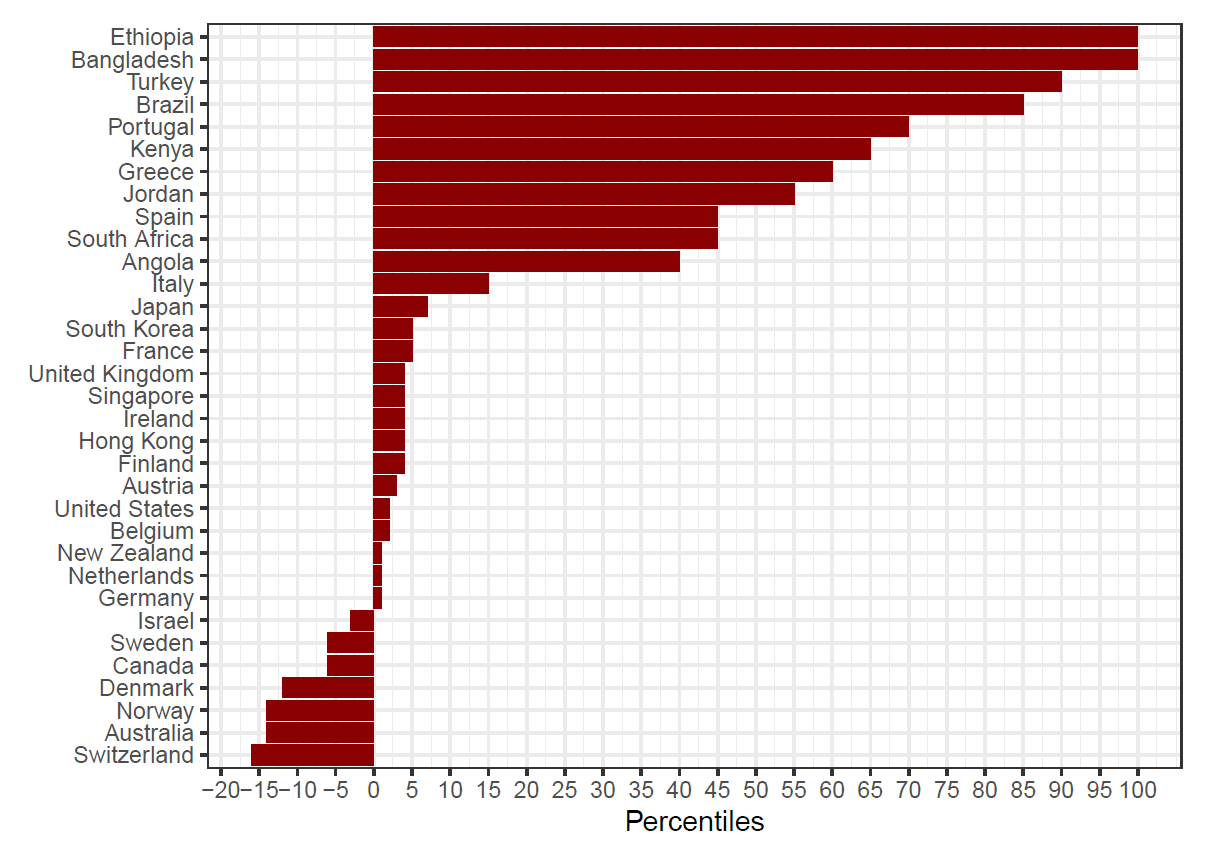Global Pay Model
To come to an equitable and fair way of determining the fixed salary of employees, MSF has developed a global pay model informed both by the international NGO market and the local market of the staff member’s country of domicile. It is a well-balanced system, with a single global salary grid that applies to all international field staff, supplemented by a home based top-up for those countries where the local market is higher than the global one.
The diagram below illustrates the global pay model, using amounts from 2022, in € for the midpoint of each level.*

The global pay model balances the need to pay international workers in a global context whilst maintaining some relativity to the markets they are recruited from.
*Please note, this diagram is for illustrative purposes only. Amounts are provided in MSF’s common currency (euros) and, as a result, are indicative only. You should contact your contracting section if you want to know your exact salary amount.
Here’s why:
- Currencies of payment vary depending on the contracting section. This would require us to present too many permutations of the numbers. Global Grid amounts and home based top-up amounts are provided to contracting sections in local currencies at the beginning of the annual period (i.e. at salary maintenance time). Exchange rates used are decided in collaboration with MSF’s international finance coordination. Salaries in local currency do not fluctuate during the year in accordance with exchange rates.
- Amounts are the total gross annual salaries defined internationally. They do not reflect the occasional necessary adaptations some contracting sections need to make, namely: as some sections may customarily or be legally required to provide a 13th salary, or other salary benefits (e.g. “holiday allowance”), the resulting nominal monthly figure may vary; In addition, a (small) number of contracting sections need to adapt certain amounts to comply with local legal constraints (e.g. minimum wage).
- Finally, the top-up amount on the graph is an average for all countries receiving a top-up, converted to euros. It does not correspond to any specific country top-up amount.
One global salary grid
The Global Grid sets out the salary for each salary level and is applied to all international field staff. It is based on the global labour market of international NGOs.
The structure of the Global Grid rewards responsibility and experience through:
Determining the Global Grid based on the iNGO market
To determine the Global Salary Grid, which applies to all international staff irrespective of their country of domicile, MSF uses market data from the international NGO market through an annual survey by the consultancy firm Birches. The survey provides MSF with the global (iNGO) salaries of a range of jobs from different levels equivalent to those in MSF’s international field function grid (IRFFG).
Given that the survey predominantly includes anglo-saxon, high-paying NGOs, and in keeping with our principle of modesty in pay, MSF applies a discount to the global market median to determine the Global Grid salary level 2 (IRFFG level 10).
Determining pay progression in the Global Grid
The remaining salary levels are calculated from this starting point, based on the MSF principle that pay should progress according to salary level (responsibility), as well as concerns of internal equity which influence the difference between lowest and highest salary overall.
Home based top-ups
In addition to the Global Grid, a ‘home based top-up’ is paid for some countries of domicile, where the local markets higher than the global one. The amount varies per country of domicile but is the same regardless of the salary level (i.e. with a fixed amount per country).
Currently, 16 countries receive a home-based top-up: Australia, Austria, Belgium, Canada, Denmark, Finland, Germany, Hong Kong, Ireland, Luxembourg, Netherlands, New Zealand, Norway, Sweden, Switzerland, United States.
The top-up for Switzerland does not apply to the staff contracted by the ICO, as it is linked to the home country where the staff are domiciled.
Determining the Home-based top-up based on local markets
To determine the home-based top-up, we refer to the different home labour markets from which MSF employs people. The top-ups are based on market data from surveys performed yearly by the consultancy firm MERCER, one of the best service providers available, covering more than 140 countries. We use the benchmark data for jobs in the Level 10 of the IRFFG (or salary level 2) as our point of comparison.
Since NGO or public sector data are not available consistently across all the local markets we need, we use ‘all industry’ data to ensure consistency of benchmark across all countries. It includes all survey participants in all sectors of activity in a country. To reflect the differences in pay one would expect between the NGO and the commercial sectors, and in keeping with the principle of modesty, we benchmark at the 25th percentile point of local market data i.e. this is the point we use to determine whether a home-based top-up is needed, and this is the position we are aiming for in the market.
This being said, the market positioning of total salaries (Global Salary + home based top-up) varies significantly depending on the country of domicile. See below, as well as more background about these choices under 'How did MSF arrive at this model').
Market positioning
MSF total pay (including top-up, where applicable, and certain core in-kind benefits such as per diem and housing) is positioned differently in each local market of the world:

Some background: How did MSF arrive at this model?
To come to an equitable and fair way of determining the salary of employees from different countries of domicile was a challenging exercise. Three typical approaches to pay were considered, each with pros and cons:
For example:
- The option of 100% Home-based pay (based on the job market of the country of domicile) presents significant differences in pay between international staff in the same mission doing the same job, but domiciled in different countries; so there would be limited internal consistency. Additionally, salaries for staff domicile in low income countries would be unacceptably low. But the question remained: How to deal with the different economic realities of different domicile countries?
- 100% Global pay, in other words, “same job, same pay” regardless of the country of domicile, offers no link with costs incurred at home, but rather on what other international NGOs are paying for international staff performing the job. This option would challenge the MSF principles of volunteerism and modesty, and would not fully reflect the reality of our international staff. It means that people in the same job get different pay (in terms of purchasing power) depending on their domicile (where they have costs and will reurn to after their international assignments).
- 100% Host-based pay or “pay based on the reality of the mission country” has no link with costs incurred in the domicile country (during the mission and/or upon return) and was probably unaffordable for the international staff in the long run. Furthermore it would create competition for more ‘favorable’ mission countries. In addition, many MSF assignments are short and staff remain de facto based in their home country (often with expenses there), and/or return thereafter or in between assignments (therefore incurring costs there as well).
Therefore, a combination of local (home-based) and global was chosen, which forms the basis for the Global Pay model. The host-based pay approach appears in the form of field per diem. With its Global Grid, it:
- Reduces pay differences between home markets
- Increases pay for nationals from low income markets
Compared to a purely local-based pay system, the global pay model:
- Increases pay equality in the field
- Equalises pay per job, at the upper levels of the organisation
- Comparatively lowers pay for expats with domicile in high income markets.


